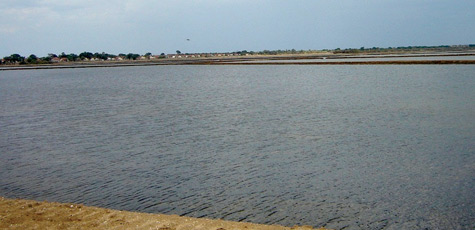Raigam to launch shrimp feed project in Kuchchaveli
By Lalin Fernandopulle
Work on the brine shrimp (Artemia) feed development project launched
by Raigam Eastern Salt (Pvt) Ltd. in Kuchchaveli in Trincomalee close to
the Eastern Saltern will launch pilot operations by mid next year, said
Raigam Eastern Salt (Pvt) Ltd. Chairman Dr. Ravi Liyanage.
He said that the project will tap the huge shrimp and inland fishery
feed market that depends heavily on feed for breeding. The annual need
of brine shrimp or Artemia is around 10,000 kilograms of which only
around 1,000 kilograms is produced locally.
"We hope to double annual production and reduce the drain of foreign
exchange on import of brine shrimp feed from Thailand, Indonesia and
Malaysia. We have the expertise and technology to develop a vibrant
market that will cater to the local and export market," Dr. Liyanage
said.
|

The Kuchchaveli Artemia development project site. |
Brine shrimp feed is produced in small quantities by private
manufacturers as the manufacturing process needs expertise and
technology. Artemia produced in Hambantota meets a small percentage of
the local need.
A kilogram of brine shrimp fluctuates between Rs. 10,000 and Rs.
15,000. Brine shrimp eggs and cysts laid by shrimp in highly saline
water and hatched in less density water is processed.
The processed egg is used as feed for shrimp and fish. Artemia is the
only genus in the family Artemiidae. The existence of Artemia dates back
to 982 from Urmia Lake, Iran. Artemia populations are found worldwide in
inland saltwater lakes, but not in oceans. Artemia avoid cohabiting with
most types of predators, such as fish, living in waters of very high
salinity (up to 25%).
Artemia produce dormant eggs, known as cysts, which has led to the
extensive use of Artemia in aquaculture. The cysts may be stored for
long periods and hatched on demand to provide a convenient form of live
feed for larval fish and crustaceans.
"Work on the project is progressing and we hope to complete phase one
by the end of 2016. The initial investment on the project is Rs. 50
million and the investment will increase with expansion," Dr. Liyanage
said.
Kingdom of Raigam, Managing Director Ganaka Amarasinghe said the
National Aquaculture Development Authority provides technical support
while the project is monitored by the Fisheries Department.
He said that the company hopes to make Kuchchaveli the largest site
for Artemia-brine shrimp development and harvest Artemia eggs.
The eggs will be processed and canned for supply as a feed for prawn
farms and aquaculture farms.
A hatchery will be developed to introduce adults to ponds.
"The company ventured into the manufacture of brine shrimp as a
by-product of its salt manufacturing business in Puttalam, Hambantota
and Kuchchaveli in the East. We hope to provide employment opportunities
to around 50 people at each project. The company will provide the
training," Amarasinghe said.
Eastern Salt hopes to produce around 1,000 kilograms under the first
stage of the project and increase production to meet the growing demand.
In the recent past, the shrimp breeding sector struggled to stay
afloat due to the spread of a disease that killed a large number of
shrimp.
Amarasinghe said that the adverse socio-environment impact is not a
hindrance to the project as the water body is already used for similar
activities of fishing and catching shrimp and the project will help
enhance the stock of fish.
Increased fish production will boost economic development and enhance
the quality of life of the fisheries community.
Southern Saltern, Tangalle and Palavi Salterns will develop Artemia
on a lesser magnitude compared to the 300-acre project in Kuchchaveli.
The three salterns operated by the company have increased production
of salt and has helped reduce imports to around 30,000 mt to meet an
annual need of around 150,000 mt.
Sri Lanka still imports around 5,000 mt of PVD (Pure Vacuum Dried )
salt a year for the high-end market. Raigam produces around 2,000 mt of
PVD salt.
|

